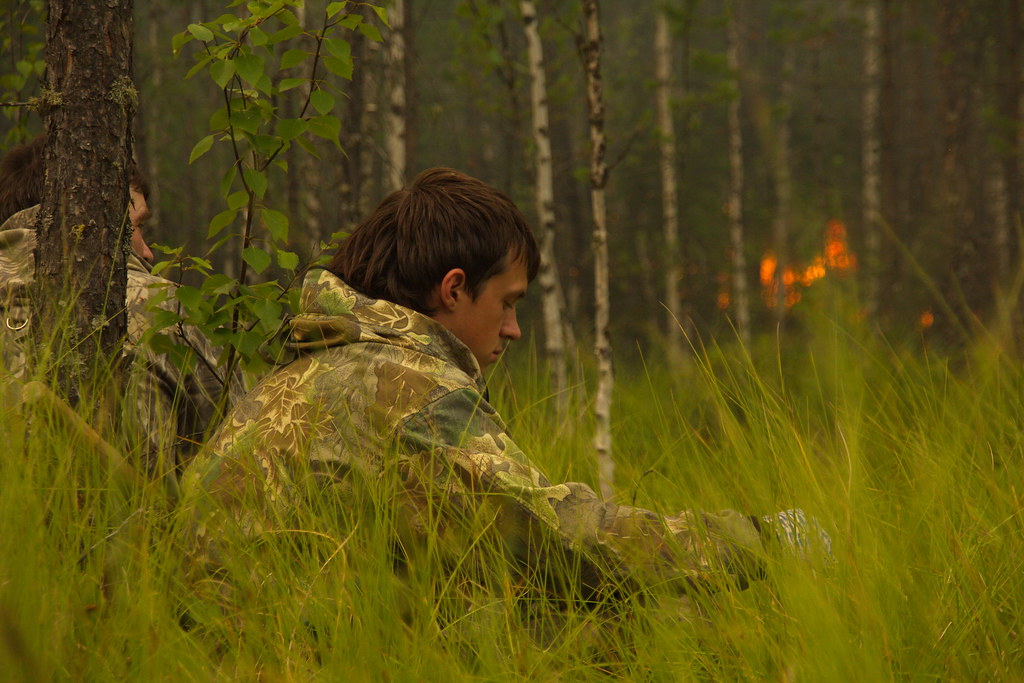今(2022)年春天西伯利亞野火提早發威,再度為俄羅斯開啟另一個破紀錄的野火季節。但此時的俄羅斯政府仍繼續忙著投入資源到俄烏戰爭。
去年野火災情慘重 相當於燒毀希臘大小的土地
今年俄羅斯已發生4,000多起火災,燒毀27萬公頃的森林,面積大約與美國羅德島州一樣大。不過,與構成整個北亞(從西部的烏拉山脈到東部的太平洋)的西伯利亞相比,這個區域仍算很小。
兩週前,俄羅斯總統蒲亭(Vladimir Putin)在電視轉播的國務會議上說,「去年森林火災是近年來歷時最久也最嚴重的一次,我們不能讓這個情況重演。」
西伯利亞一直都有野火季節,但過去兩年特別強烈。在西伯利亞部分地區,去(2021)年6月是自1888年以來最熱和最乾燥的時期。
去年的火災季節造成了巨大的環境和財產損失,且是有記錄以來最嚴重的一次。據俄羅斯綠色和平稱,去年的大火最終燒毀了1880萬公頃的土地,面積相當於整個希臘。
軍事資源全力投入戰線 俄將更缺滅火助力
儘管蒲亭對地方政府發表嚴詞,命令他們更有效地因應西伯利亞森林火災,但目前看來,今年的野火季節依然來勢洶洶。
俄羅斯綠色和平林業專家雅羅申科(Alexei Yaroshenko)告訴《路透社》,「自去年至今,一切都沒有改變。目前很可能迎來另一個大火季節。」
尤其,因為俄羅斯的資源和軍隊全投入俄烏戰爭,今年野火可能比去年更具破壞性——近年來,俄羅斯被迫動用軍事人力和直升機等資源來協助滅火,但今年這些資源都因為戰事未歇而無法用於救火。
陷入暖化惡性循環的寒冷北地
由於全球暖化,西伯利亞大火愈演愈烈。這些毀滅性的火災曾經只是互不相關的災難事件,如今卻成為西伯利亞每年例行公事。
大火席捲泥炭地和西伯利亞針葉林,釋放出永凍土儲存了數千年的溫室氣體甲烷和碳。隨著這些泥炭地和森林燃燒,儲存在泥炭和樹木中的碳全被釋放出來,進一步加劇全球暖化,形成惡性循環,可能導致未來幾年野火更加強烈。
西伯利亞今年的野火季是戰爭直接推進全球暖化的實例:俄羅斯因為戰爭,而無力保護國土免受危險火災影響,因此進一步助長全球暖化劣勢。
天候差、難滅火 野火季才剛開始 西伯利亞已進入緊急狀態
今年野火季節才剛剛開始,但已經造成生命財產損失與環境惡化。
5月7日,俄羅斯西伯利亞城市克拉斯諾亞爾斯克(Krasnoyarsk)人口稠密地區和周邊發生火災,造成八人喪生,當地已宣布進入緊急狀態。
克拉斯諾亞爾斯克地區緊急應變部門在Telegram上表示:「天候條件使滅火變得困難,狂風助長火勢並使之難以撲滅。」
克拉斯諾亞爾斯克地區行政首長烏斯(Alexandre Uss)表示,高達每秒風速40公尺的強風吹倒了該地區的樹木和電線,引發了火災。當局表示,大約有300名消防員和90輛消防車正忙著滅火。
要滅火還是繼續投入戰爭 俄羅斯面臨兩難
去年西伯利亞大火產生的煙霧飄散到世界各地,甚至到達了北極,美國太空總署(NASA)聲稱這次事件前所未見。
NASA指出,去年8月6日觀察到一層厚厚的煙霧籠罩歐亞大陸的大部分地區,「俄羅斯大部分地區都被覆蓋了。」這種煙霧對健康有負面影響,並可能惡化COVID-19引起的潛在肺部和呼吸問題。
現在,俄羅斯在決定投入多少資源來保護寶貴的生態系統、多少資源投入俄烏戰爭方面,面臨著巨大的兩難。
無論如何,除非天候狀況幸運好轉,否則俄羅斯西伯利亞地區很可能迎來另一個災難性的野火季節。
Early season wildfires in Siberia this spring threaten yet another record-breaking fire season in Russia, while the Russian government continues to pour resources into its ongoing war in Ukraine.
The more than 4,000 fires in Russia this calendar year have already burned 270,000 hectares or 1,000 square miles, an area roughly as large as the U.S. state of Rhode Island. Still, it’s a small area compared to the extent of Siberia, which constitutes all of North Asia, from the Ural Mountains in the west to the Pacific Ocean in the east.
In response to the spreading inferno, Russian President Vladimir Putin declared during a televised state meeting two weeks ago, “We cannot allow a repeat of last year’s situation, when forest fires were the most long-lasting and intensive of recent years.”
Siberia has always had a wildfire season but the past two years have been intense. In some parts of Siberia, June 2021 was the hottest and driest since 1888.
Last year’s fire season caused immense environmental and property damage and proved to be the worst on record. The 2021 fires ultimately scorched 18.8 million hectares (7,258 square miles), an area the size of Greece, according to Greenpeace Russia, a nonprofit NGO.
Despite Putin’s strong words to regional authorities and orders to them to deal more effectively with Siberian forest fires, this fire season presents a bleak outlook.
As Alexei Yaroshenko, forest expert with Greenpeace Russia, told Reuters, “Nothing has changed since last year. For now, we are likely to see another major fire season.”
The 2022 fire season could prove even more devastating than last year’s recordbreaker, as Russian resources and military forces are occupied with the unfolding war Russia is waging in Ukraine.
In recent years, Russia has been forced to call upon military personnel and resources such as helicopters to aid in firefighting efforts, a crutch that will no longer be available to Russia, which has prioritized the fire-fight with Ukraine.
From Warming to Wildfires to Faster Warming
The Siberian fires have intensified due to global warming. These devastating fires, once isolated catastrophes, are now annual facts of life in Siberia. As fires tear through the peatlands and Siberian taiga, a coniferous band of forest, they unleash the greenhouse gases methane and carbon that have been stored in the permafrost for thousands of years.
As these peatlands and forests burn, the carbon stored in the peat and the trees is released. These greenhouse gases will further contribute to global warming, and in an unfortunate positive feedback loop, likely to result in more intense wildfires in the coming years.
Siberian wildfires offer an example of war directly contributing to global warming as Russia finds itself less able to defend Russian lands from the dangerous fires which will accelerate global warming.
The wildfire season is only beginning, yet the fires this year have already caused property damage, environmental degradation, and loss of life.
Eight people perished in and around the Siberian city of Krasnoyarsk, Russia on May 7 as a fire swept through populated areas. The Krasnoyarsk region has declared a state of emergency.
“Extinguishing is being complicated by meteorological conditions – violent winds are fanning the flames and preventing them from being put out,” the Krasnoyarsk regional ministry for emergencies said on Telegram.
Krasnoyarsk Regional Governor Alexandre Uss said high winds of up to 40 metres per second, 131 feet per second, had brought down trees and power lines across the region, sparking the fires. Authorities said approximately 300 firefighters backed by 90 vehicles are fighting them.
The smoke from last year’s Siberian fires drifted around the world, even reaching the North Pole, which the U.S. National Aeronautics and Space Administration, NASA, claimed was the first time such an occurrence was witnessed.
In 2021, an expansive layer of smoke blanketed much of Eurasia with “most of Russia covered” on August 6 according to NASA. This smoke has negative health effects and could worsen underlying lung and breathing issues resulting from Covid-19.
Now, Russia faces a massive dilemma in deciding the amount of resources to devote to protecting invaluable ecosystems and how much to allocate for the war in Ukraine.
But whatever the budget, unless fortunate weather patterns occur, it appears that Russia’s Siberian region is likely to face yet another catastrophic wildfire season.
※ 全文及圖片詳見:ENS












